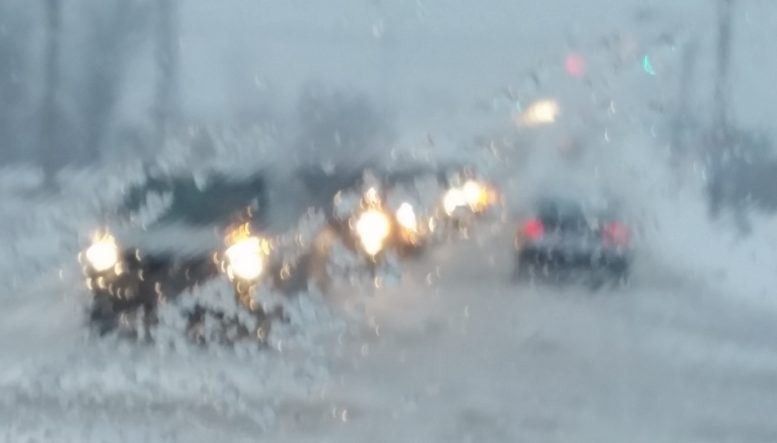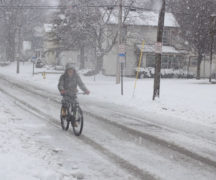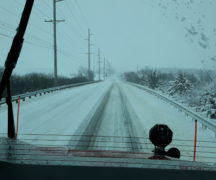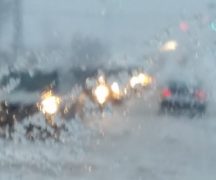By JAN LARSON McLAUGHLIN
BG Independent News
Plunging temperatures and gusting winds are expected to create havoc in this region the next few days.
As of Thursday afternoon, the Wood County Commissioners closed all non-essential offices on Friday. The Wood County Health Department and Community Health Center will be closed. And the Wood County Park District announced all park properties and facilities will be closed due to weather conditions.
Residents are filling their grocery carts with essentials, and people are being cautioned to prepare their vehicles and homes for a “flash freeze.”
In Bowling Green, city officials were working Thursday on a storm response plan. Municipal Administrator Lori Tretter said a public works team is keeping an eye on the weather predictions.
“They’ll come in tonight and assess the situation – and respond appropriately as the weather rolls in,” Tretter said.
Road crews will not be able to pre-treat streets with brine as they normally do, she said.
“With the rain, that will simply wash off whatever we put on the roads,” she explained.
“We know we may be challenged by this,” Tretter said. “But all the equipment is ready.”
Bowling Green electric crews are also ready to respond if there are power outages over the next few days.
City residents are also asked to do their parts by removing parked cars from streets wherever possible, to make it easier for snow plows to do their jobs, Tretter said.
“If you prepare today, you will thank yourself tomorrow,” she said.
In addition to the emergency service employees with the police and fire divisions, and the water and wastewater plants, Tretter said other city workers may have to show up on Christmas Eve and Christmas Day.
“It’s not ideal to have people work on the holidays,” she said. “But we want to keep our citizens safe and get the roads clear.”
WHAT’S FORECASTED
The National Weather Service in Cleveland expects:
- This is a multi-hazard weather event: wind, snow, cold into Saturday with impacts lasting until Monday.
- Rain showers have developed slower than expected but started this afternoon.
- Rain will transition to snow around midnight and expected to be approximately 2 inches by 7a.m. and tapering off around 4-6 p.m.
- There is a windchill warning from 4 a.m. Friday to 10 a.m. Saturday. Windchills are expected be -25 to-30F.
- Travel issues are expected from high winds, fresh snow and low temperatures will produce slick roadways, snow drifting causing reduced visibility.
The primary concern will be the combination of the hazardous road conditions (high winds over snow over ice) as well as the extreme cold.
WOOD COUNTY EMERGENCY MANAGEMENT AGENCY CONCERNS:
Dangerous winds and ice will make many roads impassable with whiteout/ blizzard conditions.
- Electrical lines down due to wind and ice.
- Waterline breaks.
- Dangerous wind chills for those who are outside or lose power and/or heat. Wood County wind chills will be -10F for 36- 48 hours.
- Winds will be similar to Blizzard of ‘78
Suggestions from Wood County EMA:
- As always, monitor current weather conditions for your location.
- If you don’t have to be outside to not leave home.
- If you do go out and have an issue (accident/ slide off the road) have supplies to be prepared to wait several hours or more for a tow truck.
- Make sure people know where you are going and estimated arrival time in case you do not arrive.
- Have a plan where you will go (hotel, business, friend) in case conditions worsen and you cannot safely continue.
- Make sure your destination is open and/or accessible.
- Secure loose outdoor items including holiday decorations.
- Prepare for power outages: extra fuel for generators, make sure they start and whoever will be using them knows the correct, safe operating procedures.
- Have sufficient food and supplies for the weekend.
- Prepare for your pet’s needs.
- Check on your neighbors to make sure they are safe.
- Consider changing travel plans to avoid driving on Friday.
PREPARE YOUR VEHICLE
Taking preventative measures and being prepared in the event of an emergency are key, according to the AAA.
Check Your Battery
- Starting an engine in cold temperatures can take up to twice as much current as needed under normal conditions.
- The average battery lasts 3 to 5 years. Often, there is no indication that it is not going to work. A battery that worked last week could fail under colder conditions.
- This year, AAA has seen an increase in the number of batteries needing replacement, rather than just a jump-start.
Check Your Tires
- Check tire pressure. Colder temps may require adding air to your tires. As the air temperature drops outside, so does the air pressure in your tires. For every 10-degree change in air temperature, a tire’s pressure will change by about 1-2 PSI (pounds per square inch).
- Make sure tire-pressure levels match those found in either the owner’s manual or on the driver-side door jamb. Note that pressure levels may be different for front and rear tires.
- Check tire tread. A healthy tread increases traction, essential for safe driving.
- Check for a spare tire. Many newer vehicles do not come with a spare, which many drivers do not realize until they are stranded at the roadside.
Pack a Winter Emergency Kit
No one ever ‘expects’ to break down, but being prepared can be the difference between a minor inconvenience and an extremely dangerous situation. Always have these items on hand:
- Ice scraper with brush
- Bag of abrasive material (sand, cat litter) or traction mats
- Shovel
- Flashlight with extra batteries
- Flares or reflective triangle
- Phone charger
- Blankets and extra coats/hats/gloves
- Non-perishable snacks and water
- Extra medicines
OHIO TURNPIKE RESTRICTS HIGH-PROFILE VEHICLES
In anticipation of a major weather event, the Ohio Turnpike has issued a travel restriction for all high-profile vehicles from 6 a.m., Friday, Dec. 23, to 8 a.m., Sunday, Dec. 25. (High-profile vehicles are defined as height exceeding 7 feet, 6 inches.)
The following types of vehicles will be banned from traveling on the Ohio Turnpike until the travel restriction is canceled or expires:
- All high-profile tow-behind trailers, campers, boats, and enclosed trailers. (Fifth wheel trailers are excluded.);
- Commercial trucks towing an empty single 53-foot trailer;
- All mobile homes, office trailers and livestock trailers;
- All long combination vehicles (LCV) that include long double-trailer combinations exceeding 90-feet in length. (Enclosed trailers only, including Conestoga type trailers); and
- All LCV triple-trailer combinations.
PREPARE YOUR HOME
Here are some key steps, from the Northwestern Water and Sewer District, to take before freezing weather hits:
- Turn off the water to outside faucets, remove hoses and drain the pipes
- From the inside, cover any open vents with insulation, plastic or cardboard
- On colder nights, it’s a good idea to open cabinet doors to expose pipes to your home’s warmth
- The temperature where water meters and interior pipes are located must be a minimum of 55 degrees
- On very cold nights, let your kitchen or bathroom faucets drip slowly to keep water moving
If a pipe in your home freezes:
- Shut off the water immediately. Don’t attempt to thaw frozen pipes unless the water is shut off. Freezing can often cause unseen cracks in pipes or joints.
- Completely open the cold and/or hot water faucet closest to the frozen pipe. This will relieve pressure and reduce the chance of breakage.
- Apply heat to the frozen pipe by warming the air around it, or by applying heat directly to a pipe. You can use a hair dryer, space heater or hot water. Be sure not to leave space heaters unattended.
- Do not use kerosene heaters or open flames to thaw pipes inside your home.
- Once the pipes have thawed, turn the water back on slowly and check for cracks and leaks.
- If in doubt, call a registered plumber for help
Store water
A water main break can occur at any time, but especially during winter months. Additionally, meters sometimes can freeze, causing an unexpected water outage. Be prepared: Store water for your household ahead of time. The rule of thumb is to store one-to-two gallons per person, per day, to last at least three days. Remember to store water for your pets.
KEEP SIDEWALKS CLEAR
Property owners are required to clear snow and ice from sidewalks abutting their premises within 24 hours after the abatement of a storm during which snow and ice have accumulated.
Snow removal guidelines are posted on the City of Bowling Green website. Tips include:
- Shovel early in the day. The sun will warm the surface and help melt new snow, preventing the need for deicers.
- Shovel often so snow does not become compacted and turn to ice.
- Shovel or plow your driveway and sidewalks before spreading deicer.
- Shovel before you drive a vehicle on the driveway to reduce packing snow.
Use deicers sparingly. Deicing products can have negative environmental impacts when melted snow and ice carry runoff into our ditches, streams, and rivers. Overuse of certain products, such as salts, can also damage driveways, sidewalks, vehicles, and vegetation and can be a hazard to pets. Check the label before applying. Many deicers will not work in extremely low temperatures. Use sand sparingly. Sand will not melt snow or ice but will increase traction. Sweep up excess sand to avoid adding sediment to nearby waterways.
KEEP STREETS CLEAR FOR SNOWPLOWS
Snow streets are designated throughout Bowling Green and are marked with blue and white signs. Vehicles parked on a snow street must be removed within 2 hours after a Snow Emergency is declared. If a Snow Emergency is declared overnight, vehicles must be moved by 9AM. Snow Emergencies are typically called for when the City receives 2″+ of snow. Vehicles parked in violation of snow regulations are subject to towing at the owner’s expense and/or a citation.





